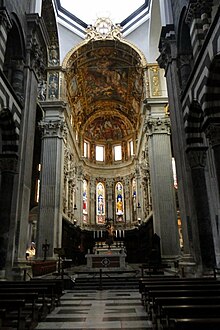Genoa Cathedral
| Genoa Cathedral Cattedrale Metropolitana di San Lorenzo | ||
|---|---|---|
Year consecrated 1118 | | |
| Location | ||
| Location | Genoa, Italy | |
| Geographic coordinates | 44°24′26.92″N 8°55′53.83″E / 44.4074778°N 8.9316194°E | |
| Architecture | ||
| Style | Gothic | |
| Groundbreaking | 1110 | |
| Completed | 17th century | |




Genoa Cathedral or Metropolitan Cathedral of Saint Lawrence (
History
Excavations under the pavement and in the area in front of today's west front have brought to light walls and pavements of Roman age as well as pre-Christian
The first cathedral, now the
Various altars and chapels have been erected between the 14th and 15th centuries. The small loggia on the north-eastern tower of the façade was built in 1455; the opposite one, in
The construction of the cathedral finished in the 17th century. The dome and the medieval parts were restored in 1894–1900. The present 7 bells are tuned in the major scale of C#.
Among the artworks inside the church are ceiling frescoes in a chapel on the north by
The Museum of the Treasury lies under the cathedral and holds a collection of jewellery and silverware from 9 AD up to the present. Among the most important pieces are the sacred bowl (it:Sacro Catino) brought by Guglielmo Embriaco after the conquest of Caesarea and supposed to be the chalice used by Christ during the Last Supper; and the Cassa Processionale del Corpus Domini.[1][2]
War damage

The cathedral had a fortunate escape on February 9, 1941, when the city was being shelled as part of Operation Grog. Because of a crew error where Midshipman Henry Hatfield aimed the gun the wrong way , the British battleship HMS Malaya fired a 381 mm (15.0 in) armour-piercing shell into the south-eastern corner of the nave. The relatively soft material failed to detonate the fuse and the shell is still there.[3]
The inscription, which gives thanks for the cathedral's escape reads:
QUESTA BOMBA LANCIATA DALLA FLOTTA INGLESE PUR SFONDANDO LE PARETI DI QUESTA INSIGNE CATTEDRALE QUI CADEVA INESPLOSA IL IX FEBBRAIO MCMXLI
A RICONOSCENZA PERENNE GENOVA CITTÀ DI MARIA VOLLE INCISA IN PIETRA LA MEMORIA DI TANTA GRAZIA
(This bomb, launched by the British Navy, though breaking through the walls of this great cathedral, fell here unexploded on February 9, 1941. In perpetual gratitude, Genoa, the City of Mary, desired to engrave in stone, the memory of such grace.)
See also
- Domenico Bellando: cathedral organist from 1885–1912.
- List of cathedrals
- Roman Catholic Archdiocese of Genoa
References
- ^ Genoa in 4 Hour by Edizioni GMT in English
- ^ Website of the Museo del tesoro di San Lorenzo(in Italian)
- ^ "Obituary:Commander Henry Hatfield". Daily Telegraph. 4 July 2010. Retrieved 5 July 2010.
External links
- Padovano, Aldo; Felice Volpe (2008). La grande storia di Genova Enciclopedia. Artemisia Progetti Editoriali. pp. 81–82.
- Efthalia Rentetzi, Gli affreschi bizantini nella cattedrale di Genova. Una nuova lettura iconografica in“Arte |Documento” (2012).
